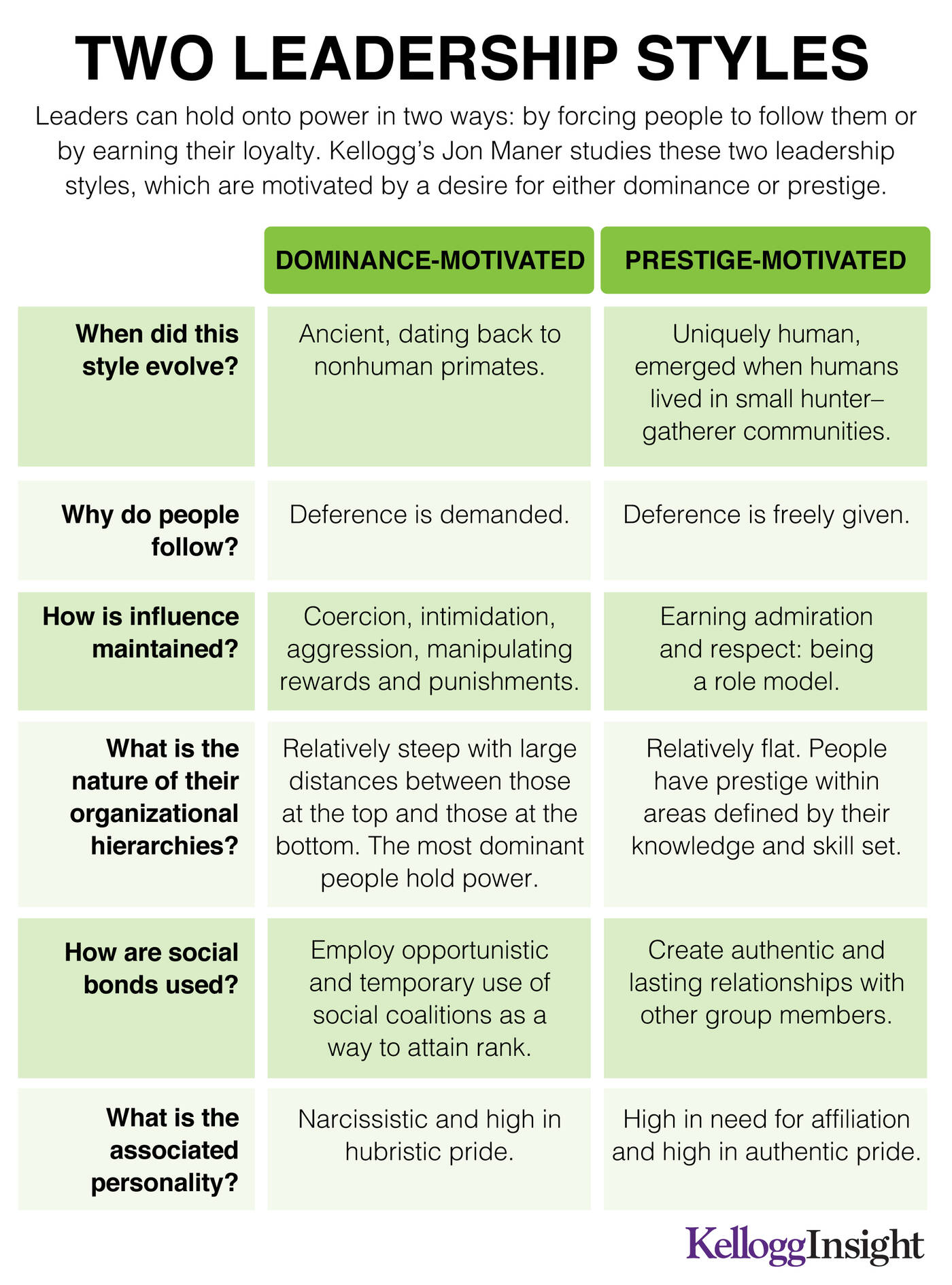Leadership Organizations Careers Sep 6, 2016
How to Be a Good Boss: Start by Understanding Why You Want to Lead
Research explores the pros and cons of two distinct leadership styles.

Michael Meier
Kids on the playground and military generals both know that there are two ways to hold onto power. You either dominate everyone and demand their support, or you get them to like you and offer up their fealty freely.
Those two leadership styles—motivated by the desire for either dominance or prestige—are examined in research from Kellogg’s Jon Maner. Each one has pros and cons, and they work best under different circumstances.
“It’s not that one strategy is good and one strategy is bad,” Maner says. “They both can work in different kinds of organizations.”
And both can work within the same leader. The research shows that most people who have a drive to lead others harbor both skill sets; one is just generally more dominant than the other. The key to effective leadership, Maner says, is to be able to nimbly switch between them.
“Although the two traits are positively correlated, they have very, very different consequences for leadership behavior, often opposite consequences.”
“Part of maturing as a leader is self-insight,” says Maner, a professor of management and organizations. “And a lot of that self-insight involves knowing who you are as a leader and where your skills lie. How can you learn to leverage the strengths of both mindsets while avoiding the pitfalls of each? Because they do each have pitfalls.”
Dominance vs. Prestige
One of the most interesting findings, Maner says, is the strong correlation between a desire for power and being motivated by both dominance and prestige.
“Although the two traits are positively correlated, they have very, very different consequences for leadership behavior,” Maner says, “often opposite consequences.”
Maner’s recent research, which he conducted with Charleen Case, a visiting pre-doctoral scholar at Kellogg, is an in-depth look at of both his own and others’ studies. It takes an evolutionary perspective, noting that primates have a long history of using dominance techniques, while prestige-motivated leaders are a strictly human phenomenon. Looked at in aggregate, the studies paint a clear picture of the two types of leaders.
Dominance-motivated leaders rise through the ranks and gain followers via intimidation and coercion.
“They demand deference instead of allowing it to be freely offered,” Maner says.
There are upsides to this. They are swift, decisive decision makers and are good at uniting an organization behind a single vision. However, these leaders are sometimes willing to sacrifice the best interest of the group in order to keep their hands on the levers of power. (Read more about Maner’s research on why bad bosses sabotage their teams.)

For instance, participants in one experiment were told they were leading a group and had to decide which subordinates to assign to a difficult verbal task and to a difficult math task. One subordinate was particularly gifted in verbal skills, they were told.
Dominance-motivated participants who believed their grasp on power within the group was tenuous were much more likely to assign that subordinate to the math task, even though the performance of the group would ostensibly suffer. This kept the talented subordinate from shining too brightly. Conversely, participants who tested as being high in prestige motivation assigned that subordinate to the verbal task.
Prestige-oriented leaders achieve their status by displaying their knowledge and skills, and convincing people they are worth following. They are good at fostering creativity and getting their teams to innovate. However, because their power comes from being liked, they can sometimes forgo making the right decision in favor of a popular decision. Additionally, “they pull their punches when it comes to giving hard feedback,” Maner says.
One study found that prestige-oriented leaders go against what they see as the best course of action for the organization when making a public decision that will be unpopular. But if the decision is made without subordinates knowing, these same leaders will stick with the best choice for the group.
Leadership Styles in Action
In his classes, Maner points to Steve Jobs and Warren Buffett as examples of dominance- versus prestige-driven leadership styles. These days, it is hard to contemplate these two styles and not immediately think of Donald Trump and Hillary Clinton.
“Trump is a paradigmatic example of a dominant leader,” Maner says. “ Clinton, I think, and Obama for that matter, are much better at fostering relationships. And that’s much more about prestige.”
Interestingly, Maner’s research consistently shows that there is no correlation between leadership style and gender.
“Everybody has the intuition that men are more dominant, and I have to admit that when we started this program of research, we had that intuition as well,” Maner says. “However, we never found [a correlation]. Women are just as likely to deploy both of these strategies as men are.”
Identifying Your Leadership Style
So what kind of leader are you? Maner offers some easy ways to tell.
Do you find yourself doing most of the talking in meetings? If so, you are likely a dominance-motivated leader. “Whereas, if you’re doing more listening, you’re probably more prestige-oriented.”
Another question to ask yourself: Do you often mentally step into the shoes of your employee? If so, you are likely a prestige-motivated leader.
There are similar litmus tests you can do when you are hiring or assessing team members.
Try to put the person in a group setting, Maner suggests. “Dominant people tend to dominate conversations,” Maner says. “They don’t listen very well. While other people are talking, they’re thinking about the next thing they’re going to say.”
A tricky wrinkle is that dominance can often initially masquerade as competence.
“They may not know the most, but they assert themselves in ways that make them seem like they do,” Maner says. So, as a check, try to give candidates an objective test of their knowledge and skills, or have someone join an interview who can quickly assess whether what the person is asserting is correct.
Another subtle signal of leadership style, which bears out in studies of other primates, is that dominance-motivated people tend to lower their voice when asserting themselves in a social situation.
“People who care more about the relationship, they don’t do that because it’s intimidating and other people don’t like it,” Maner says.
The Right Leader for the Right Organization
Maner knows that much of the research in this field has painted a fairly magnanimous picture of prestige-motivated leaders. And, if you have to pick one, he says prestige is the better bet.
But the choice really comes down to what your organization’s goals are.
“When you need all the people on your team to present a unified front and move quickly in a common direction, when you don’t have time to have people thinking outside the box, that situation really calls for a dominant leader,” Maner says. “Conversely, if you’re trying to get your team to innovate or produce creative solutions, that calls for more of a prestige-oriented strategy.”
Your organization’s structure can also dictate which sort of leader will thrive. Very hierarchical organizations with large power gaps between positions appeal to dominance-motivated leaders. “They really like to have a lot of distance between themselves and their underlings because that helps them maintain power,” Maner explains.
Those large power gaps make prestige-motivated leaders uncomfortable. “It makes them feel anxious because they really value the relationships,” he says. “They tend to work best in organizations that are relatively flat.”
The research shows that dominant leaders are willing to sabotage their own teams when they feel their power is unstable within the organization. Yet the opposite is true when faced with an external competing group. This tends to galvanize dominance-motivated leaders to prioritize “the good of the group over any selfish desires,” Maner says.
So organizations with a strong dominant leader might benefit from highlighting the successes of their competitors to keep their leader’s bad instincts in check.
Because most leaders are versed in both leadership styles, the key is knowing when to slip into each mode, Maner says.
“Good leaders intuit the need for one strategy over another,” Maner says. “But there is always room for improvement in knowing which hat to wear depending on the situation.”
Maner, Jon K., Charleen R. Case. 2016. “Dominance and Prestige: Dual Strategies for Navigating Social Hierarchies.” Advances in Experimental Social Psychology. In press.



